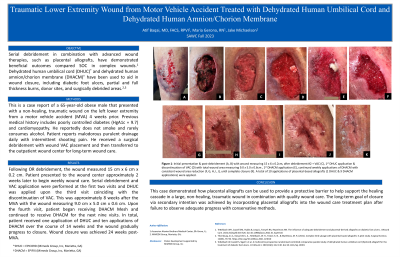Case Series/Study
(CS-018) Traumatic Lower Extremity Wound from Motor Vehicle Accident Treated with Dehydrated Human Umbilical Cord and Dehydrated Human Amnion/Chorion Membrane

Serial debridement in combination with advanced wound therapies, such as placental allografts, have demonstrated beneficial outcomes compared SOC in complex wounds.1 Dehydrated human umbilical cord (DHUC) and dehydrated human amnion/chorion membrane (DHACM) have been used to aid in wound closure, including diabetic foot ulcers, partial and full thickness burns, donor sites, and surgically debrided areas.2,3
Methods:
This is a case report of a 65-year-old obese male that presented with a non-healing, traumatic wound on the left lower extremity from a motor vehicle accident (MVA) 4 weeks prior. Previous medical history includes poorly controlled diabetes (HgA1c = 9.7) and cardiomyopathy. He reportedly does not smoke and rarely consumes alcohol. Patient reports malodorous purulent drainage daily with intermittent shooting pain. He received a surgical debridement with wound VAC placement and then transferred to the outpatient wound center for long-term wound care.
Results:
This is a case report of a 65-year-old obese male that presented with a non-healing, traumatic wound on the left lower extremity from a motor vehicle accident (MVA) 4 weeks prior. Previous medical history includes poorly controlled diabetes (HgA1c = 9.7) and cardiomyopathy. He reportedly does not smoke and rarely consumes alcohol. Patient reports malodorous purulent drainage daily with intermittent shooting pain. He received a surgical debridement with wound VAC placement and then transferred to the outpatient wound center for long-term wound care.
Discussion: This case demonstrated how placental allografts can be used to provide a protective barrier to help support the healing cascade in a large, non-healing, traumatic wound in combination with quality wound care. The long-term goal of closure via secondary intention was achieved by incorporating placental allografts into the wound care treatment plan after failure to observe adequate progress with conservative methods
Trademarked Items:
References: 1. Tettelbach WH, Cazzell SM, Hubbs B, Jong JL, Forsyth RA, Reyzelman AM. The influence of adequate debridement and placental-derived allografts on diabetic foot ulcers. J Wound Care. 2022;31(Sup9):S16-S26. doi:10.12968/jowc.2022.31.Sup9.S16
2. Thornburg, D. A., Kowal-Vern, A., Tettelbach, W. H., Foster, K. N., & Matthews, M. R. (2021). Complex limb salvage with placental-based allografts: A pilot study. Surgical Science, 12(03), 76–94. https://doi.org/10.4236/ss.2021.123010
3. Tettelbach W, Cazzell S, Sigal F, et al. A multicentre prospective randomised controlled comparative parallel study of dehydrated human umbilical cord (EpiCord) allograft for the treatment of diabetic foot ulcers. Int Wound J. 2019;16(1):122-130. doi:10.1111/iwj.13001

.png)